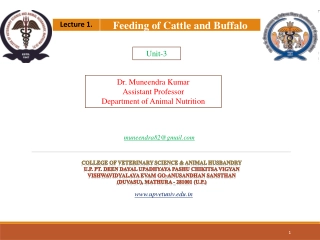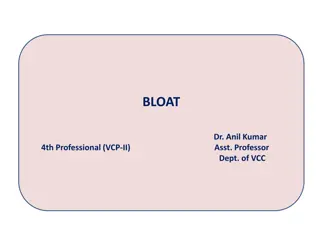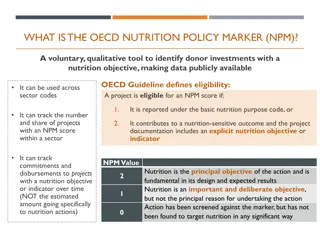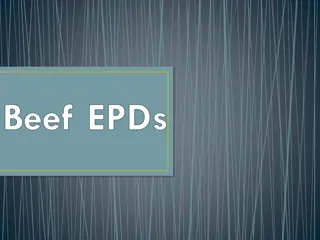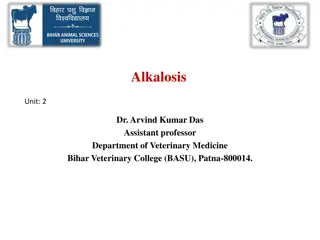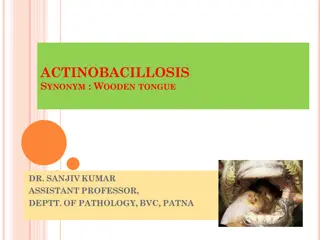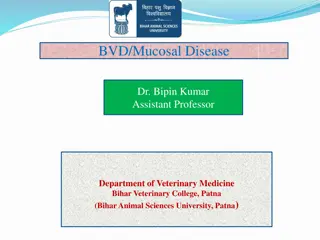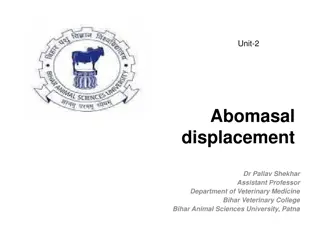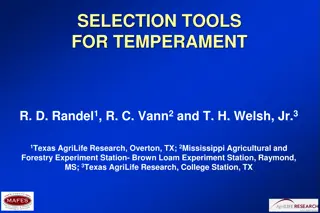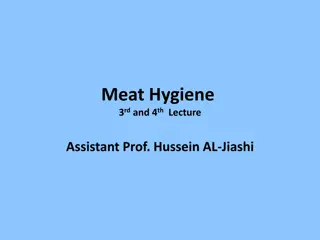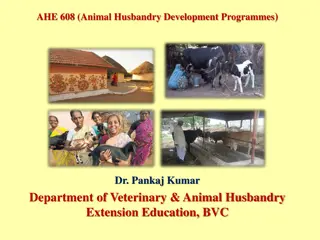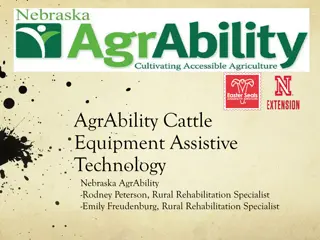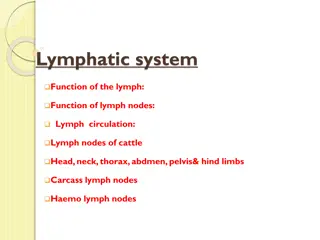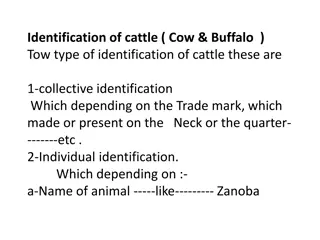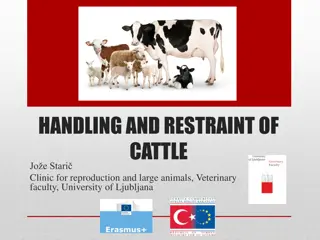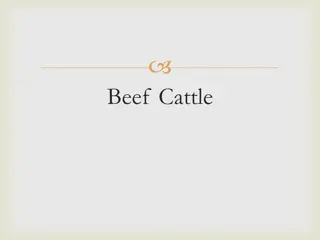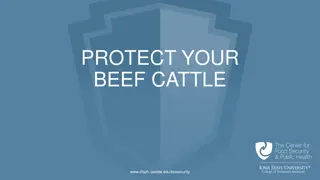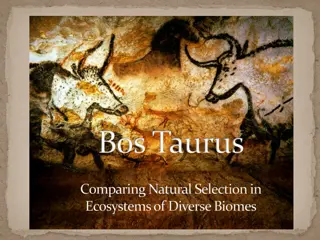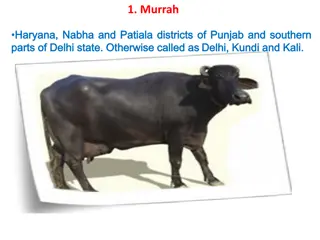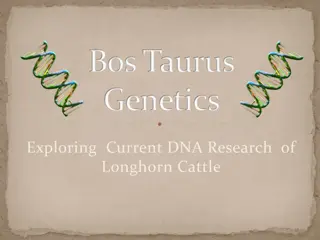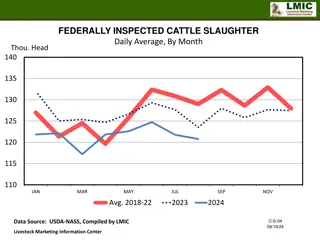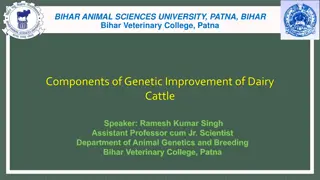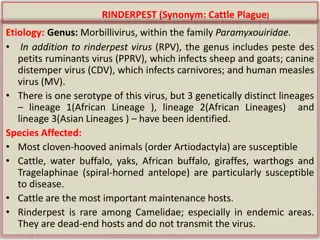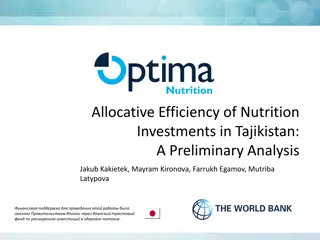BSc Food Science & Human Nutrition Programme Overview
This BSc Food Science & Human Nutrition programme at Maynooth University offers a comprehensive understanding of nutrition, biology, and chemistry as applied to food. With a focus on ingredients, production, products, and nutrition, students explore various aspects of food science including food saf
3 views • 12 slides
Feeding of Cattle and Buffalo
Explore the key concepts of ration formulation for feeding cattle and buffalo, focusing on balanced nutrition, ingredients, characteristics of a good ration, and best practices to ensure optimal health and productivity. Learn from Dr. Muneendra Kumar, Assistant Professor at the Department of Animal
0 views • 58 slides
Alina Michalska - Nutrition Specialist with UNICEF ESARO
Alina Michalska is a Nutrition Specialist with UNICEF Eastern and Southern Africa Regional Office (ESARO) based in Nairobi. She has a strong background in nutrition information systems and has worked on various projects to improve nutrition outcomes in different regions. With a Master's degree from
3 views • 22 slides
Multi-Sectoral Nutrition Information System (MNIS) Overview and Implementation Details
The Multi-Sectoral Nutrition Information System (MNIS) is a web-based platform used by the National Food and Nutrition Commission (NFNC) in Zambia to collect essential data for monitoring and decision-making in the nutrition sector. MNIS facilitates the gathering of functional information to support
1 views • 10 slides
Understanding Bloat in Cattle: Causes, Symptoms, and Treatment
Bloat in cattle, characterized by overdistension of the rumenoreticulum with gases of fermentation, can be caused by various factors including diet, obstruction, or diseases. Frothy bloat and free gas bloat are common types, each with its own triggers and symptoms. Diagnosis involves a thorough hist
1 views • 8 slides
Understanding the OECD Nutrition Policy Marker (NPM)
The OECD Nutrition Policy Marker (NPM) is a voluntary tool to identify donor investments with a nutrition objective. It helps mainstream nutrition in large-scale programs to improve outcomes and accountability. The NPM is applied at the project level to track investments and promote transparency in
1 views • 4 slides
Understanding Expected Progeny Differences (EPDs) in Beef Cattle Selection
Expected Progeny Differences (EPDs) in beef cattle breeding predict future offspring performance based on genetic merit. They help compare animals as parents and aid in selecting for traits like birth weight, weaning weight, and yearling weight. Combining EPDs with visual appraisal improves decision
0 views • 15 slides
Livestock Breeding Policy for Genetic Improvement of Cattle and Buffalo in India
India's diverse agro-ecological regions host a wide range of farm animal breeds. The livestock breeding policy aims to enhance the productivity of cattle and buffalo through strategies such as grading up with indigenous superior dairy breeds, crossbreeding with high-yielding exotic breeds, and selec
1 views • 23 slides
Understanding Alkalosis in Cattle: Causes and Pathophysiology
Alkalosis in cattle, particularly ruminal alkalosis, can be caused by issues such as abomasal atony and alkaline indigestion. Excessive intake of protein-rich feed and changes in diet play a significant role. Pathophysiology involves the accumulation of ruminal ammonia, leading to alkaline pH and ru
1 views • 13 slides
Synergistic Role of Agriculture, Health, and Education in Nutrition Programs
Agriculture, health, and education play vital roles in nutrition program implementation. They are interconnected as agricultural practices impact health and nutrition outcomes. Agriculture is crucial for providing essential nutrition, while the health of individuals in agriculture affects productivi
2 views • 9 slides
Enhancing Pre-Service Nutrition Education for Nurses and Midwives in Ghana and Malawi
This project led by Alice Nkoroi focused on improving access and quality of nutrition services in Ghana and Malawi by enhancing pre-service nutrition education for frontline workers like nurses and midwives. The approach involved stakeholder consultation, defining core nutrition competencies, and co
1 views • 16 slides
Actinobacillosis (Wooden Tongue) in Cattle and Sheep: Overview of the Infectious Disease
Actinobacillosis, also known as Wooden Tongue, is a specific infectious disease affecting cattle and sheep, caused by Actinobacillus lignieresii. It is characterized by fibrosis of the tongue and soft tissues, leading to mobility issues. The disease is primarily transmitted through wounds and abrasi
0 views • 8 slides
Understanding Bovine Virus Diarrhea and Mucosal Disease in Cattle
Bovine Virus Diarrhea (BVD) and Mucosal Disease (MD) are two clinically distinct yet interconnected syndromes in cattle caused by Pestivirus. While originally thought to be separate, they share a common viral etiology. BVD can lead to persistent infections, while MD is sporadic, progressive, and fat
0 views • 14 slides
Understanding Abomasal Displacement in Dairy Cattle: Causes, Symptoms, and Management
Abomasal displacement is a common issue in older lactating dairy cattle, often related to inadequate nutrition and concurrent diseases. This condition involves the displacement of the abomasum from its normal position, causing symptoms like anorexia, ketosis, and dehydration. Learn about the causes,
1 views • 21 slides
Understanding Sand Crack in Cattle Hooves: Causes, Signs, and Treatment
Sand crack, a fissure of the horny wall in cattle hooves, can present transversely or longitudinally. It commonly affects dairy breeds and is predisposed by various factors such as overgrowth of digital horn and chronic laminitis. Diagnosis and treatment differ based on the form of the crack, with s
0 views • 10 slides
Understanding Cattle Temperament: Implications for Producers
Cattle temperament plays a crucial role in the overall well-being of livestock and can impact factors such as stress levels, growth rates, and immune function. This article delves into the importance of evaluating and managing temperament in cattle to mitigate risks of injury, reduce stress-related
2 views • 32 slides
Common Infective Diseases in Cattle and Their Implications
Infective diseases such as blackquarter, brucellosis, and foot and mouth disease pose significant threats to cattle health and food safety. Blackquarter is a fatal disease caused by Clostridium chauvaei, while brucellosis leads to contagious abortion in cattle. Foot and mouth disease is highly conta
0 views • 17 slides
Dairy Cattle Production Systems in Ethiopia: Overview and Practices
Ethiopia has a favorable environment for dairy development with diverse production systems including pastoralism, agro-pastoralism, and mixed farming. The country boasts indigenous and exotic dairy cattle breeds, supporting milk production and utilization. This article outlines the different dairy p
2 views • 38 slides
Animal Husbandry Development Initiatives in India: Gaushalas and Gosadans
Animal Husbandry Development Programmes in India have a rich history dating back thousands of years, with initiatives like Gaushalas and Gosadans playing a significant role in preserving indigenous cattle breeds, promoting milk production, and supporting rural economies. Gaushalas aim to breed and u
0 views • 10 slides
Integrating Nutrition Assessment and Counselling for Clients with Active Tuberculosis
This training course emphasizes the critical relationship between nutrition and tuberculosis (TB), highlighting how undernutrition impacts TB infection and the implications of TB-HIV co-infections on nutritional status. Participants will learn about managing nutrition for individuals with active TB,
1 views • 29 slides
History and Vocabulary of Cattle Farming
Explore the rich history of cattle farming, from the introduction of longhorn cattle in America by the Spanish to the importation of European dairy cattle to Jamestown Colony. Learn about various terms and concepts associated with cattle, such as castration, heifer, marbling, and more. Delve into th
0 views • 36 slides
Addressing Challenges in the Cattle Market: A Call to Action
Explore the concept of Black Swan events in the cattle market and how they can affect market dynamics negatively. The presentation by R-CALF USA delves into instances where markets respond counter to fundamentals and overreact to minor stimuli. Issues such as high captive supply levels and import sp
0 views • 12 slides
Enhancing Cattle Farming with Assistive Technology in Nebraska
Nebraska AgrAbility specialists, Rodney Peterson and Emily Freudenburg, discuss the impact of modern equipment on cattle farmers with disabilities. They highlight the evolution of technology in cattle farming, introduce a new hydraulic feed box for efficient feeding, and provide vendor contact infor
0 views • 25 slides
Understanding Cattle Management and Classification
Cattle, belonging to the genus Bos, are classified into three types - Bos Taurus, Bos Indicus, and Bos Africans. They are ruminants with fixed hollow horns, udders with four teats, and males have teats on the scrotum. Cattle are utilized for milk production, agriculture, and meat manufacturing. They
0 views • 70 slides
Sustainable Nutrition Multisectoral Commitments in Nigeria
Presentation at the 52nd Annual General Meeting of the Nutrition Society of Nigeria highlighting the importance of nurturing multisectoral commitments for sustainable nutrition in Nigeria. The Federal Government identified six priority areas of nutrition for investment in the National Multi-Sectoral
0 views • 9 slides
Feasibility Study: Measuring Ruminal Contractions of Cattle Using an Inexpensive Electronic Veterinary Stethoscope
Effects of gastrointestinal motility in understanding disease and nutrition in cattle are actively researched. This study explores monitoring ruminal contractions using a cost-effective electronic stethoscope. The device, developed with Arduino technology, showed promising results in capturing inter
0 views • 35 slides
Understanding the Lymphatic System in Cattle: Nodes, Circulation, and Function
The lymphatic system in cattle plays a crucial role in maintaining overall health. It consists of lymph nodes located in various regions of the body such as the head, neck, abdomen, and hind limbs. These lymph nodes produce lymphocytes and help in filtering foreign bodies. Lymph fluid, similar to bl
0 views • 39 slides
Cattle Identification Methods and Characteristics Explained
Explore different methods of identifying cattle including collective and individual methods such as branding, tattooing, and tagging. Learn about cattle species, breeds, colors, and aging factors like dentition and parturition. Discover the main color variations in cattle such as yellow, red, black,
0 views • 36 slides
Understanding Cattle Handling and Restraint Techniques
Explore the importance of understanding cattle senses and behaviors for effective handling and restraint. Learn about domestication history, handling techniques, sensory perception, and more to ensure safe interactions with cattle. Gain insights into vision, hearing, and other senses crucial for pro
1 views • 30 slides
Overview of Beef Cattle Breeds and Characteristics
In the United States, there are over 80 recognized breeds of beef cattle, each with its own advantages and disadvantages. British breeds like Angus and Hereford offer low birth weight and high fertility, while European breeds like Charolais and Simmental excel in growth rate and milk production. Oth
0 views • 24 slides
Protect Your Beef Cattle: Prevent Diseases and Ensure Animal Health
Diseases can harm the health of beef cattle and lead to costly consequences. Learn how to protect your herd by taking biosecurity measures to prevent the spread of diseases. This material, developed with support from USDA, emphasizes the importance of proactive steps to safeguard your beef cattle.
0 views • 5 slides
Comparing Natural Selection in Diverse Biomes: Spanish Cattle Adaptations
Explore the natural selection of Spanish cattle in desert, swamp, and grassland ecosystems. Compare characteristics of Cracker and Chinampo cattle, highlighting their adaptations for survival in different biomes. Discover how these species thrive in challenging environments through unique physical a
0 views • 11 slides
Brucellosis in Cattle and Buffaloes in Bikaner, Rajasthan, India
Brucellosis, caused by Brucella abortus, is a serious disease in cattle and buffaloes with significant public health and trade consequences. The disease is prevalent in India and poses a substantial economic impact. WHO recognizes brucellosis as a zoonotic disease, affecting both animals and humans.
0 views • 17 slides
Diverse Breeds of Dairy Cattle in India
Explore various breeds of dairy cattle in India, such as Murrah from Haryana, Surti Kaira from Gujarat, Jaffrabadi, Bhadawari, Nili Ravi, Mehsana, and Nagpuri. Each breed has unique characteristics like lactation yield, fat content, and breeding tracts. Discover the rich diversity and potential of I
0 views • 15 slides
Exploring Longhorn Cattle Genetics Through DNA Research
Longhorn cattle genetics are being investigated through DNA research to identify unique traits and differentiate them from other cattle breeds. By analyzing genetic codes with scatter plot graphs, scientists aim to map the genetic makeup of Longhorns accurately. This research helps in understanding
0 views • 9 slides
Overview of Federally Inspected Cattle Slaughter Data
This data compilation provides insights into federally inspected cattle slaughter on a daily, weekly, and monthly basis, along with specific details on cow slaughter, commercial cattle slaughter, heifer slaughter, cow slaughter, steer slaughter, and beef cow slaughter. The information covers average
0 views • 16 slides
Respiratory Diseases in Cattle: Causes, Infections, and Management
Respiratory diseases in cattle primarily stem from infectious agents such as infectious bovine rhinotracheitis and Pasteurella spp. These diseases compromise the defense mechanisms of the body, leading to infections like pneumonia and pleuropneumonia. Viruses, mycoplasmas, and bacteria like Histophi
0 views • 31 slides
Genetic Improvement of Dairy Cattle: Key Components and Strategies
Understanding the genetic improvement of dairy cattle is crucial for enhancing milk production. This article explores the key components involved, such as unique identification systems, parentage recording, milk yield monitoring, artificial insemination, and genetic evaluation methods. Achieving exc
0 views • 11 slides
Understanding Rinderpest: A Cattle Plague Overview
Rinderpest, also known as Cattle Plague, is caused by the Morbillivirus and primarily affects cloven-hooved animals like cattle and buffalo. It is transmitted through contact with infected animals and has distinct clinical signs ranging from fever and mucopurulent secretions to severe hemorrhagic di
0 views • 14 slides
Optima Nutrition: Maximizing Efficiency of Nutrition Investments in Tajikistan
Preliminary analysis on the allocative efficiency of nutrition investments in Tajikistan reveals the potential impact of Optima Nutrition in optimizing resource allocation for various interventions. The tool aims to enhance the cost-effectiveness and effectiveness of public health investments in nut
0 views • 23 slides

